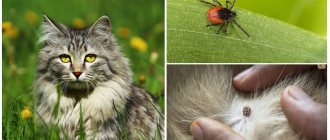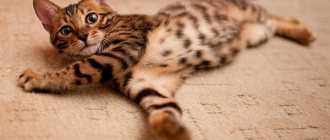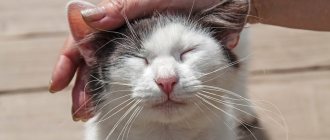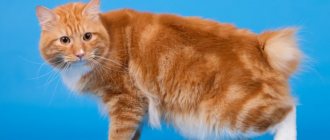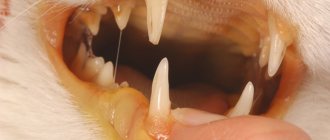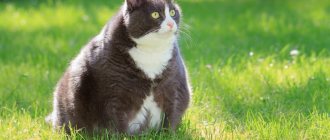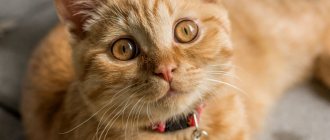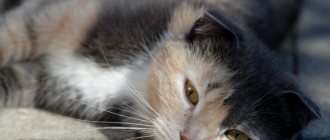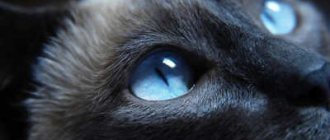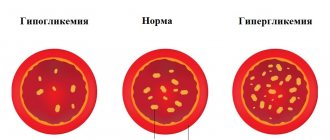Why do you need cat shampoo?
In general, cat shampoo helps cleanse the animal's fur of dirt. Pets rarely need this due to their anatomical features and penchant for cleanliness. Due to possible side effects and the animals’ dislike of water, they try to bathe them only when strictly necessary.
Mats cause pain and itching in animals; matted hair can later lead to scratching, wound rotting and tissue infection, so it is important to deal with the problem in a timely manner
Depending on the type and specialization of the shampoo, it can perform additional functions. For example, antiparasitic medications help repel fleas. If the composition contains powerful active substances, the shampoo can paralyze or even kill insects. Anti-matt products make the coat smoother, help break up existing clumps and prevent the formation of new ones. Cosmetic shampoos may be used before the exhibition.
Many pet owners have a question about whether it is possible to replace cat shampoo with human shampoo. Despite the fact that in most cases a specialized product is sold in concentrated form, i.e. it is used sparingly, the difference in cost is colossal. Unfortunately, cat skin is more delicate and dry, so human shampoo will cause flaking and increased work of the sebaceous glands. My friend tried to bathe her cat with delicate baby shampoos, but they often cause deterioration in the quality of the coat. As a result, my pet’s fur coat began to get dirty faster. The animal’s condition has still not returned to normal, although the friend refused to use baby shampoos.
Preliminary preparation for swimming. Degreasing
A specific problem, especially for long-haired cats, is greasy tail.
Veterinarians refer to this phenomenon as the tail of a breeding cat - stud tail .
The hormonal activity of the animal provokes the production of a paraffin-like substance, as a result of which the first half or even a third of the tail is covered with sticky hair with a waxy coating.
This problem is faced not only by active cats, but also by neutered ones, but to a lesser extent.
This tail requires special care . Without degreasing, dust accumulates on the lubricant, the fur becomes matted, which prevents the skin from breathing and promotes inflammation of the sebaceous glands.
Advanced cases are characterized by the appearance of a shabby, acne-prone tail.
You can cope with the problem in several ways, using various care products.
These methods will help degrease the fur in other problem areas, such as the area behind the ears and collar .
Dry shampoo
The tail is cleaned using dry brushing . Why do you apply starch or dry shampoo to it?
The powder is rubbed into the roots of the hairs, and after absorbing the fat, it is intensively combed out.
However, such procedures, especially if there is strong greasiness, irritate the animal and are often accompanied by tearing out large amounts of hair.
It is much easier to apply dry shampoo immediately before bathing procedures.
Depending on the global nature of the problem, you will need to let the powder sit on the wool from several hours to a day. During this time, all the fat from the hairs is absorbed into the powder, after which it is washed out.
You can use baby powder or the professional dry shampoos below.
Mr.gee - dry shampoo with zinc and chamomile for dogs and cats
Dry shampoo is made from white clay.
White clay absorbs excess oil and dirt from the coat, relieves inflammation, and provides natural protection.
Zinc and chamomile have a calming, healing effect and have a beneficial effect on irritated skin. Composed:
- kaolin (caolin);
- talc (talcum);
- zinc Zn (Zincum);
- chamomile (Matricaria).
Manufacturer: Russia
Estimated cost: 327 rub. for 95 g
Special degreasing pastes
Severe fatness occurs in breeding cats.
Special pastes help to cope with the problem; they must be applied to the area of greasy hair on dry wool 5-15 minutes before washing.
Using unprofessional products or improvised degreasing gels and pastes, as some breeders recommend, without some experience is dangerous for the animal.
Baldecchi Cat Line Sgrass – degreasing paste
The product is specially designed for degreasing the hair and skin of cats of such breeds as Himalayan, Persian, and Maine Coon.
It will greatly facilitate the grooming process by removing greasy deposits from the coat.
Directions for use: Apply to greasy areas before bathing with a toothbrush. It is necessary to leave it on the wool for up to 15 minutes.
Manufacturer: Italy, Baldecchi.
Estimated cost: 1100-1200 rubles. for 250 ml.
How to choose shampoo for a cat
First you need to decide on the main specialization of the shampoo. If this is a medicinal product, then you need to contact a veterinarian. The specialist will select the best option, taking into account the disease and individual characteristics. If we are talking exclusively about a classic cosmetic product, then you can do it on your own.
Owners of animals with special needs should pay attention to gentle shampoos: ordinary products can cause adverse reactions in kittens and sphinxes. Experimenting is not recommended, since severe damage may result in deterioration in the quality of the coat, the appearance of tangles, the development of dermatological diseases, etc. It is better to make the choice after studying the reviews.
Long-haired cats require a suitable shampoo, as regular shampoo will cause tangling of the hairs.
When purchasing anti-parasite shampoo, you need to clarify its specialization. Just because a product kills fleas does not mean it is equally effective at killing ticks. The effectiveness of the shampoo should depend not only on the degree of threat of infection, but also on the health of the animal.
In the case of kittens, pregnant and sick animals, it is better to refrain from using a specialized product. Shampoos kill insects thanks to toxic active substances. The latter have a negative impact not only on parasites, but also on the cats themselves. In the case of healthy pets, the negative impact is practically not felt, however, in weakened animals, symptoms of intoxication may appear: nausea, vomiting, dizziness, etc. Cases of death are known. If strictly necessary, it is better to prefer natural shampoos with herbal extracts. They do not kill, but only repel fleas, but do not have such a strong effect on the health of pets.
If possible, repellent shampoos are strongly recommended to be combined with other products, since they only provide prevention
When choosing the consistency of the shampoo, you should take into account the pet’s personality traits. Most cats do not like sprays because the spray makes them scared and aggressive. Powder products are easier to use and do not involve the use of water, so they are suitable for travelers and owners of show animals. They can also be purchased by owners of overly aggressive pets.
You should not self-medicate! Even dandruff is a reason to first conduct an examination, and not act at random. When my sister’s cat’s skin began to peel, she, on the advice of a salesperson at a pet store, purchased a special shampoo. The remedy didn't help. The problem only got worse. A month later, it was painful to look at the cat: his hair began to fall out, his skin itched and came off in large layers. As a result, I had to go to the vet. It turned out that the cat had a banal food allergy, but the use of antifungal shampoo also disrupted the functioning of the sebaceous glands and natural microflora. As a result, the sister was forced not only to change the pet’s food, but also to take a long time to restore the condition of the skin. Even after the allergy disappeared, the peeling continued for 2–3 months.
Table: choosing a shampoo tone depending on color
| Shampoo tone | Cat color |
| White | White, silver marble, chinchilla, sometimes blue, blue-cream or lilac |
| Red | Red, turtle |
| Bronze | Red, turtle |
| Black | Black or dark (smoky) |
| Purple | Blue, blue-cream, cream |
How often can you bathe your cat with shampoo?
Since even the mildest shampoo has a negative effect on the skin and helps to wash away the protective fatty film, people try to avoid hygiene procedures. Cats are good at grooming themselves, so if there are no individual problems, there is no need to create a bathing schedule.
Bathing your cat too often can cause your cat's skin to peel off; as a result of activation of the sebaceous glands, the coat becomes dirty even faster
Hygienic procedures are carried out in the following cases:
- Before the exhibition. Shampoo is used as needed, but try to avoid too frequent bathing (more than once every 2 weeks), since even protective and restorative agents are not able to completely neutralize the negative effects.
- In case of excessive contamination. If the cat gets dirty with something that it cannot get rid of on its own or is dangerous to health, use liquid shampoos or sprays.
- For prevention. For example, with an increased threat of bacterial infection or during the peak season of parasite activity.
- When fleas are found. Shampoos are used for treatment if the cat cannot be treated with special drops. Most often, the drugs are used for prevention, because they are not effective enough. Anti-flea shampoos can be used every 2 weeks: during this time, the larvae, which may not have been affected by the active substances, turn into adults. Treatment is carried out until complete recovery, i.e. 2–3 months. This is the full life cycle of a flea.
- For treatment. The schedule depends on the indications and prescriptions of the veterinarian. In most cases, treatment is carried out every 7–14 days until complete recovery.
If there is a need for regular procedures, they are carried out every few months depending on the pet’s lifestyle. For example, outdoor animals are bathed every 4-6 weeks. Domestic cats get dirty less often, so it is enough to wash them once every 3-4 months. The skin of sphinxes is cared for regularly: gentle shampoos, depending on the characteristics of the sebaceous glands, are used every 1–2 weeks.
It is impossible to give a definite answer to the question of how often you can bathe a cat. Too many factors influence the schedule: individual characteristics, type of shampoo, health status, etc. For example, my cat is accustomed to washing and is calm about hygiene procedures. In the spring, I decided to bathe her with anti-flea shampoo, so as not to use too aggressive products again. After the first time the condition was normal. After 2 weeks I repeated the procedure. The cat was weak all day, slept in her house, and in the evening she began to feel sick. There was no such reaction after cosmetic shampoos, so I attributed what was happening to individual characteristics. I didn't experiment anymore.
What is undesirable and dangerous to wash
Not all cosmetics are suitable for cats, because they have their own characteristics. For example, the pH of their skin is up to 7.5, while the human pH is lower - about 5.5. This means that cat skin does not tolerate an acidic environment and the aggressive effects of chemicals. There are also dangerous substances for them, which, however, are successfully used for people and even for the treatment of dogs and horses. Because of this, cats should not be washed with the following shampoos and products.
Normal human or child
Human shampoo (including baby shampoo) is more aggressive on cats’ skin, dries and can cause irritation.
What are the best clippers for cats with thick hair and how much do they cost?
Degtyarny
Tar shampoos - tar can be dangerous, as it strongly dries and burns the epidermis of cats; even veterinary drugs containing it are prescribed with extreme caution and in minimal doses.
Laundry soap
Laundry soap dries and irritates the skin, causing itching and severe scratching.
Medicines for dogs
Shampoo for dogs is not so scary, but the structure of their skin and coat is different, so the effect can be completely unexpected.
Adult, strong and healthy cats sometimes do not respond at all to the use of the above remedies. And for a sick or small pet, just one wash with the wrong shampoo can result in serious skin irritation and damage to the coat.
Features of using shampoos
Features depend on the type of shampoo.
Medicinal shampoo
It is impossible to highlight the features of medicinal shampoos in general, since there are many subtypes intended for the treatment of a particular disease. However, manufacturers often recommend leaving the product on the coat for 3-5 minutes before rinsing. This is due to the need for deep penetration of active substances: if you remove the shampoo too early, it simply will not work.
Dry shampoo
You should wear gloves before the procedure. After removing additional accessories from the animal, the powder is evenly distributed over the dry fur. Then you need to start rubbing the powder into the hairs, moving along the line against the growth. During the process, you should avoid getting the powder on the mucous membranes. After a few minutes, you need to comb the cat with a brush to get rid of some of the powder and dead hairs. You should not do this too carefully, because you still won’t be able to remove all the powder.
Anti-flea shampoo
When washing, it is important to thoroughly treat all areas of the body. If you leave the head and ear area alone, fleas will move there to escape the toxins. This is fraught with a complete lack of effectiveness. After the procedure, if there is a confirmed infection, the animal should be combed to remove remaining insects, dead individuals and some of the larvae.
Tint shampoo
The color should match the shade of your pet's coat. For example, white shampoo is used to bathe white cats or animals with silver merle and chinchilla colors. In the first case, leave the product on the fur coat for 2-3 minutes, then wash it off. This is necessary for deep whitening. If the color is not completely white, keep the shampoo for no more than 1 minute.
Sometimes white shampoo is used to lightly lighten lilac, blue-cream and blue coats. The effect is individual, so it is better to trust a professional groomer. As a last resort, you need to experiment between exhibitions. Incorrect coloring may result in a deduction or disqualification.
If the use of shampoo is due to preparation for an exhibition, it is advisable to carry out “training” procedures in advance. Optimally - in a month. This will help you evaluate the result and correct errors in a timely manner. Each cat’s coat, as well as its skin type, has individual characteristics, so often the appearance of animals, even when using the same product, differs: some people’s hairs get dirty faster, others more slowly. It's even more difficult with shades. For example, I found out experimentally that one of my cats’ fur begins to get dirty after just 2 days, while another cat’s fur begins to get dirty after about the fourth day. This helps you plan your schedule.
Dry without rinsing
Leave-in shampoos are hygiene products in cramped conditions. They are convenient for trips, at exhibitions, when there is no water, when the cat gets a little dirty. They also help remove sebum from the roots, add additional volume and refresh the styling done the day before. Leave-in shampoos come in the following types:
- dry in spray;
- in the form of loose powder;
- in the form of foam.
They are quite simple to use. All of them are applied to the length of the coat or the root zone. It is advisable to avoid contact with the skin, as the product is more difficult to remove from it without additional effort. After applying leave-in shampoo, usually wait a few minutes (according to the instructions, but no more than 5 minutes) and carefully treat the strands with a fine-toothed comb or massage comb. Shampoo particles absorb dirt, and then the whole thing is removed by combing. The effect usually lasts for a couple of days.
Dry shampoo or foam cannot be a complete replacement for regular cleaning cosmetics for cats. Leave-in products are intended for emergencies because they do not completely remove stains.
Review of popular brands
Let's look at the most popular shampoos for cats.
"Doctor"
“Doctor” is a line of shampoos that includes 3 products: a classic remedy, a preparation with climbazole and with tar. The composition includes softened water, sodium lauryl sulfate, glycerin, citric acid, coconut oil fatty acid derivative, etc.
Shampoo with tar can help with bacterial and fungal infections, as well as with improper functioning of the sebaceous glands, but the reaction is often individual
Classic shampoo has a cosmetic effect and removes dirt. The drug with climbazole destroys pathogenic fungi, suppresses itching and inflammation, and also regulates the functioning of the sebaceous glands. The product with tar has an antibacterial effect and helps moisturize the skin.
All 3 shampoos are available in 250 ml bottles. The average cost of a package is 265 rubles.
"Celandine"
“Clandestine” is a series of shampoos, sprays and powder against fleas. The detergent contains permethrin, which helps fight insects. "Clandestine" can be used for both medicinal and preventive purposes.
The improved formula implies the presence of lavender oil in the composition, which ensures not only the destruction of existing insects, but also repels parasites
There are several types of shampoos. These include products for kittens, for adult cats, restorative and detangling preparations, etc. A standard bottle (220 ml) costs 110–120 rubles.
"BioVax"
The Biovax shampoo line includes both cosmetic and antiparasitic drugs. The first series consists of several recipes, which are developed taking into account age characteristics and type of wool (hard, long, etc.). The shampoos contain herbal ingredients that have a preventive effect. For example, tea tree oil has been added to the product for short-haired cats, which has an antibacterial effect.
The line contains a combination product that helps get rid of most parasites
Shampoos are produced in large bottles (350 ml). The average cost of such packaging is 120–160 rubles.
Elite Professional
Elite Professional is a series of professional cosmetic shampoos. The manufacturer claims that the products do not contain ingredients of animal origin. The use of synthetic additives is kept to a minimum. The composition is based on plant extracts and amino acids, which helps to avoid negative reactions from the skin.
The company has developed many recipes taking into account the characteristics of animals, so choosing the right shampoo is not difficult
A small bottle (270 ml) costs 330 rubles. Sometimes you can find large packages (1 l) and canisters (5 l) on sale, but their purchase is more relevant for groomers.
Beaphar
The Beafar line of shampoos consists of cosmetic and antiparasitic products. The series even contains cleaning powder. Shampoos are suitable for animals with sensitive skin and help get rid of mats. The manufacturer includes herbal additives (for example, macadamia oil), but in small quantities.
The company is famous for its therapeutic and prophylactic formulations, so shampoos can be used even by animals that are prone to allergies
150 g of cleaning powder costs 800 rubles. The average price of shampoos (315 g) is 570 rubles. The high cost is partly due to the popularity of the brand.
The best hygiene products
British Shorthair - a normal grooming product will do for a healthy pet
These shampoos should gently cleanse the cat's fur coat and skin without causing irritation or itching. After bathing, the coat should have a beautiful shine, look elastic and bouncy. Read the instructions for use of the drug carefully.
“Api-San Velvet care” 220 ml – 220 RUR
Api-San Velvet care
A universal preparation with a subtle aroma of almonds and citrus based on vegetable oils, hyaluronic and citric acids, and chemical components . The amount of substance for a single procedure is calculated based on the weight of the animal: 1 ml per 1 kg.
